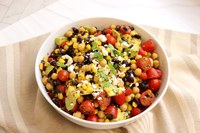Prairie Fare: Nourish Your Brain with Food and Fitness
(Click an image below to view a high-resolution image that can be downloaded)
By Julie Garden-Robinson, food and nutrition specialist
NDSU Extension
After a hectic several days, my body and brain were tired but still a bit “wired.”
In fact, I woke up at 3 a.m. thinking I needed to keep working on projects. I had finished them.
Has that ever happened to you?
What should a person do? I did what you should not do. I turned on ultra-early morning TV.
“Infomercials” caught my attention. These advertisements can make you feel insufficient in many parts of your life. Effective marketing makes us feel a “need” for items.
As I flipped through the channels, I could order a better wardrobe and jewelry, a new mattress, home-exercise equipment, all sorts of dietary supplements and many kitchen appliances.
However, I did not call the toll-free number and spend my money on a supplement to improve my brain health.
I decided closing my eyes was my best strategy. Unfortunately, I overslept and had 10 minutes to get out the door in the morning.
Besides sleep, you may find the best strategy for brain and body health is in your refrigerator, freezer or cupboards. A good pair of walking shoes also can support brain health, if you use them regularly.
When you take care of your heart through regular exercise and a healthful diet, you also are taking care of your brain.
Many of the risk factors for age-related memory impairment are the same risk factors for heart disease. High blood cholesterol, high blood pressure, diabetes and obesity increase our risk.
Instead of turning to supplements, take a closer look at your diet. Think of the body as a car. Consider food as fuel.
Oxidative damage in the human body is similar to how a car rusts. The free radicals that affect our body are like the salt, sand and other elements that damage a car. Oxidative damage occurs when harmful molecules called free radicals cause damage to the body’s cells.
The natural antioxidants in fruits, vegetables and pulses (such as black beans and chickpeas) can help protect the cells throughout the body. Too much damage to our cells can promote everything from heart disease to some brain health issues.
Be sure to eat a balance of foods from all the food groups: grains, dairy and other calcium sources, a variety of protein foods, along with fruits and vegetables.
These are some examples of antioxidant nutrients and foods that are their best sources. Are these foods regularly on your plate or in your grocery cart?
- Citrus fruits, broccoli, brussels sprouts, strawberries and cantaloupe are excellent sources of vitamin C.
- Vegetable oils (corn, canola, sunflower, soybean and olive oils), nuts, leafy greens and some fortified cereals provide vitamin E.
- Meat, fish, poultry, eggs, milk and some fortified breakfast cereals provide vitamin B12.
- Leafy, green vegetables, dry edible beans and fortified cereals provide the B vitamin f
- Dark-colored vegetables such as sweet potatoes, carrots, kale, spinach and winter squash
provide beta-carotene. - Omega-3 fats are brain-healthy too. The fats are found in fish, especially pink salmon, trout, albacore tuna and shrimp. A plant-based omega-3 fat is found in flaxseed oil, canola oil, soybean oil and walnuts.
- Selenium is an antioxidant mineral found in seafood, mushrooms, whole grains, poultry, liver, beef, soybeans, seeds, nuts and a variety of other foods.
If you rarely eat any of the above foods, you may want to visit with a dietitian or healthcare provider to make some healthful adjustments to your diet as a first step.
Regular physical activity and learning new skills go hand in hand with nutrition and brain health. Aim for at least 30 minutes of physical activity. In one study, dancing was the No. 1 physical activity that helped decrease the onset of dementia. Doing crossword puzzles also helped lower the risk of dementia.
Regular physical activity can help you sleep all night so you are less likely to wake up and watch infomercials at night. Sleep is good for your brain too.
Here’s an antioxidant-rich salad with healthful fats.
Southwest Chickpea Salad
1 (15-ounce) can black beans, drained and rinsed
1 (15-ounce) can chickpeas, drained and rinsed
2 cups frozen corn, thawed, or 1 (15-oz.) can corn, drained and rinsed
1 pint cherry tomatoes, sliced in half
2 medium avocados, diced
1 (2.25-ounce) can sliced black olives, drained
Dressing:
Juice of one lime
2 tablespoons extra virgin olive oil
1 teaspoon cumin
1/4 teaspoon chili powder
1/4 teaspoon salt
1/4 cup fresh cilantro, chopped
1/4 cup feta cheese, crumbled, for garnish (optional)
In a large bowl, combine black beans, chickpeas, corn, tomatoes, avocados and olives. In a small bowl, whisk the lime juice, olive oil, cumin, chili powder, salt and cilantro. Add the dressing to the salad and toss until combined. Garnish with feta cheese.
Makes 10 servings. Without feta cheese, each serving has 210 calories, 8 g fat, 9 g protein, 30 g carbohydrate, 9 g fiber and 400 mg sodium.
(Julie Garden-Robinson, Ph.D., R.D., L.R.D., is a North Dakota State University Extension food and nutrition specialist and professor in the Department of Health, Nutrition and Exercise Sciences. Follow her on Twitter @jgardenrobinson)
NDSU Agriculture Communication – April 7, 2022
Source: Julie Garden-Robinson, 701-231-7187, julie.garden-robinson@ndsu.edu
Editor: Elizabeth Cronin, 701-231-5391, elizabeth.cronin@ndsu.edu




